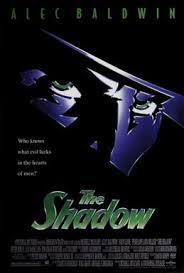At the end of the First World War Lamont Cranston (Alec Baldwin) ends up in Tibet. Renaming himself Ying-Ko, the former playboy becomes a warlord, a drug kingpin, and an all-around nasty. Cranston is kidnapped by a Buddhist spiritual master, the Tulku (Brady Tsurutani). The Tulku tells him that he will be redeemed but to earn redemption he must fight against evil. Under the Tulku’s tutelage Cranston learns how to cloud men’s minds by concentrating and by developing his psychic abilities. Using his abilities, he can either appear to be invisible or confuse people in what they are thinking. The only part of him that he cannot hide is his shadow.
After his lessons Cranston returns to his former home in New York City. He resumes his playboy status while combating crime as his alter ego, The Shadow. His uncle, Police Commissioner Wainwright (Jonathan Winters) is not happy that a vigilante has taken up residence in his city. Cranston recruits a loyal following from some of the people he has saved. He gives those who have a skill which he may need sometime in the future a red signet ring and code words to identify any currier he sends to them for help.
One evening, while having dinner with his uncle, he meets Margo Lane (Penelope Ann Miller), a socialite who happens to also be telepathic. The two have instant chemistry together, but Cranston knows that her abilities could reveal his secret life. He vows to keep her at arm’s length but a former student of the Tulku, Shiwan Khan (John Lone), comes to New York to take over the western world and uses Margo in his scheme. Margo’s father is Dr. Reinhardt Lane (Ian McKellen), a noted scientist working with the War Department. Shiwan, using the same Eastern Arts as Cranston, hypnotizes Reinhardt into creating an atomic bomb.
“The Shadow” was released in 1994 and was directed by Russell Mulcahy. It is a superhero mystery thriller.
You can’t help but love all the tropes in this movie, especially when they are accompanied by a sweeping music score by Jerry Goldsmith. Not only does it have most of the standard “Shadow” tropes but sprinkled in are notes of steampunk, art deco, and noir wrapped up with some slightly campy scenes and standard pulp novel elements. I don’t understand why it didn’t do better at the box office. It’s got everything you need in a superhero style thriller. It also aligns with the character shaped in the original radio series as well as the pulp version.
Alec Baldwin is also great as the handsome and suave Lamont Cranston. His dark looks blend well with The Shadow’s mystery. I also liked the transition made between Cranston and The Shadow. One aspect of the character you might notice in the film is Alec Baldwin’s nose. When he is The Shadow his face changes and the contour of his nose becomes straighter and a bit more aquiline. Baldwin also has that great dusky voice that lends well to the haunting laugh that’s The Shadow’s trademark.
The visuals are also great. There are a lot of rich looking Hammer-esque sets and wonderful thirties fashions. There are also some good actors in the film. It’s actually a great movie. It’s just not Marvel or DC.
The film also sports a rousing theme song done by Taylor Dayne.
Movie
Taylor Dayne Theme Song


